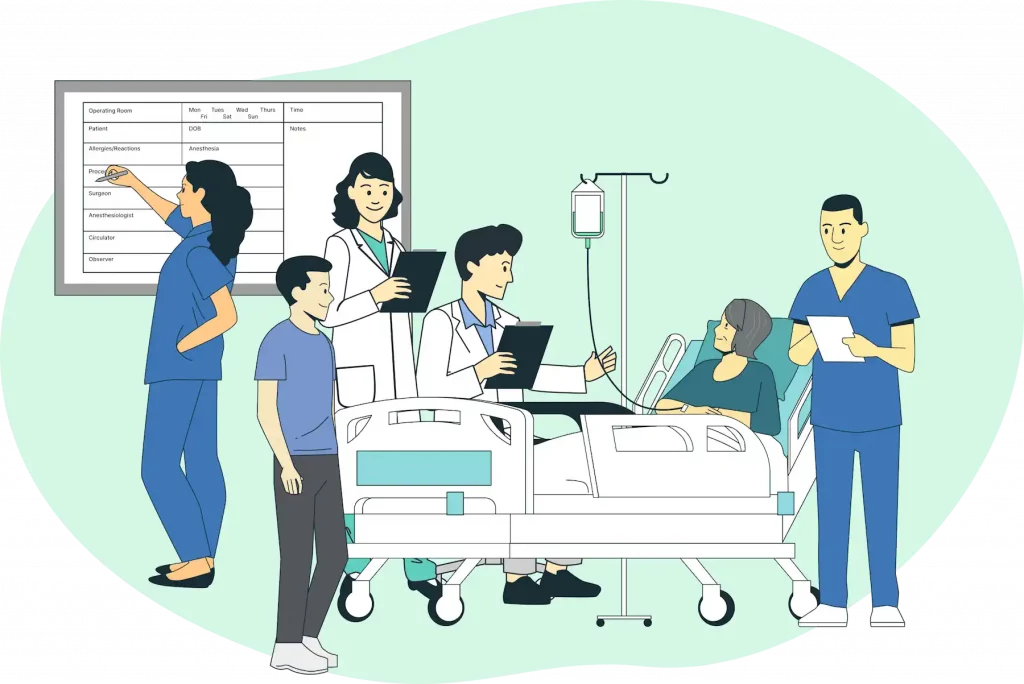Situational Awareness
What is Situational Awareness?
‘Situation awareness’ (SA) refers to an individual’s perception of the information within a task environment, comprehension of its meaning and anticipation of potential future states (Endsley, 1995). In clinical settings, care delivery is predominantly team based, with multiple stakeholders contributing to the overall recovery of each patient. Team ‘situational awareness’ (Team SA) therefore refers to a shared perception of data, comprehension of its significance, and projection of potential future states.
Situational Awareness in High-Reliability Organizations
High-Reliability Organizations (HROs) offer a model for teamwork and team development, based on the concept of High-Reliability Teams (HRTs) (Wilson et al., 2005, Alvarez and Coiera, 2006). Wilson et al. (2005) identified ‘Sensitivity to operations’ as a key feature of HRTs, who’s use of closed loop communication strategies and processes to exchange information in order to promote shared situational awareness of the internal and external factors influencing the team. These closed loop communication strategies set HRTs apart from traditional team structures that fail to provide a level of service that is assured.


Enhancing Patient Safety through Team Situational Awareness
Reader et al discussed the importance of Team Situational Awareness in care teams, with Team SA being especially important for acute care teams owing to the reliance on multidisciplinary teamwork and complex patient populations. Specifically Team SA is important during daily rounds, where teams collaborate to review patients and share information pertinent to specific roles and care tasks (eg, daily goals). The Team SA created during daily rounds influences patient monitoring, task prioritization, and anticipating emerging conditions or patient needs. Poor Team SA regarding a patient’s condition or emergent needs have greater potential for uncoordinated and erroneous care delivery.


Addressing Failure to Rescue (FTR) with Effective Team Situational Awareness
The presence of new or persistent abnormalities (e.g. SIRS criteria, delirium, oliguria, uncontrolled pain, etc.) can be discounted if not framed by meaningful context or trending within the care team, i.e. increased Team SA. ‘Failure to Rescue’ (FTR) is a measure of hospital quality of care (named by the Agency of Health Care Quality as one of 20 patient safety indicators.) and is defined as is defined as the probability of death after a complication or adverse occurrence within a particular hospital. The risk of FTR is decreased if complications and adverse occurrences are identified efficiently and mitigated aggressively. Conversely, the risk of FTR increases when negative changes in patient status occur and interventions to address the decline are not taken. Reducing FTR requires three key phases that frequently require interdisciplinary care within the care team:
- Failure to detect: if the team does not notice the negative progression they will have no chance to correct it.
- Failure to indicate: if detected, the team member must then bring it to the attention of the rest of the team. Failing to indicate limits the team’s ability to intervene as required.
- Failure to correct: once indicated, the team must still determine the appropriate corrective action and deliver it correctly to the patient.
Teams with higher levels of Team SA about their patients have a greater potential to maximize the three phases above, as their shared perception, comprehension and projection of care will not only be better, but also more efficient.
Leveraging Situation Awareness in Accountable Care Units
| Component | Cognitive Function | Explanation |
|---|---|---|
| Perception (what?) | Contextual | Significant data from interval history, events, or finding |
| Comprehension (so what?) | Temporal | Appreciation of significance in light of trend(s) |
| Projection (now what?) | Integrative | Prediction of course with & without adjustments to plan |
Teams with Situational Awareness can for example:
- Correct safety oversights (e.g. order VTE prophylaxis or remove an idle catheter)
- Identify early indications of clinical deterioration (e.g. develop contingency plans for persistent abnormal vital signs)
- Re-evaluate the diagnosis or treatment plan (e.g. re-consider surgical options).
Accountable Care Units are specifically designed, through unit-based teams and SIBR, to maximize Team SA by directly creating interval reviews by the care team that focus on the common known potential risk states of hospitalization, while progressing recovery ad proactively addressing patient needs and discharge planning.
To explore these concepts further and discover more practical strategies for improving Team Situation Awareness and integrating other advanced teamwork concepts in your teams visit our Resources.